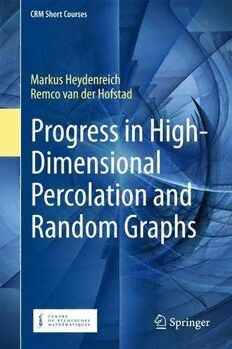Table Of ContentCRM Short Courses
Markus Heydenreich
Remco van der Hofstad
Progress in High-
Dimensional
Percolation and
Random Graphs
CRM Short Courses
SeriesEditor
GaliaDafni,ConcordiaUniversity,Montreal,QC,Canada
EditorialBoard
MireilleBousquet-Mélou(CNRS,LaBRI,UniversitédeBordeaux)
AntonioCórdobaBarba(ICMAT,UniversidadAutónomadeMadrid)
SvetlanaJitomirskaya(UCIrvine)
V.KumarMurty(UniversityofToronto)
LeonidPolterovich(TelAvivUniversity)
ThevolumesintheCRMShortCoursesserieshaveaprimarilyinstructionalaim,focusing
onpresentingtopicsofcurrentinteresttoreadersrangingfromgraduatestudentstoexperi-
encedresearchersinthemathematicalsciences.Eachtextisaimedatbringingthereaderto
theforefrontofresearchinaparticularareaorfield,andcanconsistofoneorseveralcourses
with a unified theme. The inclusion of exercises, while welcome, is not strictly required.
Publicationsarelargelybutnotexclusively,basedonschools,instructionalworkshopsand
lectureserieshostedby,oraffiliatedwith,theCentredeResearchesMathématiques(CRM).
Specialemphasisisgiventothequalityofexpositionandpedagogicalvalueofeachtext.
Moreinformationaboutthisseriesathttp://www.springer.com/series/15360
Markus Heydenreich (cid:2) Remco van der Hofstad
Progress in High-Dimensional
Percolation and Random
Graphs
MarkusHeydenreich RemcovanderHofstad
MathematischesInstitut DepartmentofMathematicsand
Ludwig-Maximilians-UniversitätMünchen ComputerScience
Munich,Bayern EindhovenUniversityofTechnology
Germany Eindhoven
TheNetherlands
CRMShortCourses
ISBN978-3-319-62472-3 ISBN978-3-319-62473-0(eBook)
DOI10.1007/978-3-319-62473-0
LibraryofCongressControlNumber:2017945258
MathematicsSubjectClassification(2010):60K35,60K37,82B43
©SpringerInternationalPublishingSwitzerland2017
This work is subject to copyright. All rights are reserved by the Publisher, whether the whole or part of the
material is concerned, specifically the rights of translation, reprinting, reuse of illustrations, recitation, broad-
casting, reproduction on microfilms or in any other physical way, and transmission or information storage and
retrieval,electronicadaptation,computersoftware,orbysimilarordissimilarmethodologynowknownorhereafter
developed.
Theuseofgeneraldescriptivenames,registerednames,trademarks,servicemarks,etc.inthispublicationdoesnot
imply,evenintheabsenceofaspecificstatement,thatsuchnamesareexemptfromtherelevantprotectivelawsand
regulationsandthereforefreeforgeneraluse.
Thepublisher,theauthorsandtheeditorsaresafetoassumethattheadviceandinformationinthisbookarebelieved
tobetrueandaccurateatthedateofpublication.Neitherthepublishernortheauthorsortheeditorsgiveawar-
ranty,expressorimplied,withrespecttothematerialcontainedhereinorforanyerrorsoromissionsthatmayhave
beenmade.Thepublisherremainsneutralwithregardtojurisdictionalclaimsinpublishedmapsandinstitutional
affiliations.
Printedonacid-freepaper
ThisSpringerimprintispublishedbySpringerNature
TheregisteredcompanyisSpringerInternationalPublishingAG
Theregisteredcompanyaddressis:Gewerbestrasse11,6330Cham,Switzerland
Preface
Thisbookfocusesonpercolationonhigh-dimensionallattices.Wegiveageneralintroduction
topercolation,statingthemainresultsanddefiningthecentralobjects.Weassumenoprior
knowledge about percolation. This text is aimed at graduate students and researchers who
wishtoenterthewondrousworldofhigh-dimensionalpercolation,withtheaimtodemystify
thelace-expansionmethodologythathasbeenthekeytechniqueinhighdimensions.Thistext
canbeusedforreadingseminarsoradvancedcoursesaswellasforreferenceandindividual
study.Theexpositioniscomplementedwithmanyexercises,andweinvitereaderstotrythem
outandgaindeeperunderstandingofthetechniquespresentedhere.Letusnowsummarize
thecontentinmoredetail.
We describe mean-field results in high-dimensional percolation that make the intuition
that“farawaycriticalpercolationclustersareclosetobeingindependent”precise.Wehave
two main purposes. The first main purpose is to give a self-contained proof of mean-field
behavior for high-dimensional percolation, by proving that percolation in high dimensions
hasmean-field criticalexponents ˇ D (cid:2) D 1,ı D 2and(cid:3) D 0,asforpercolation onthe
tree. This proof is obtained by combining the Aizenman–Newman and Barsky–Aizenman
differential inequalities, that rely on the triangle condition, with the lace-expansion proof
ofHaraandSladeoftheinfraredboundthat,inturn,verifiesthetrianglecondition.While
thereareexpositorytextsdiscussinglace-expansionmethodology,suchasSlade’sexcellent
Saint-Flourlecturenotes,anintroductiontohigh-dimensionalpercolationdidnotyetexist.
Asidefromtheseclassicalresults,thatarenowover25yearsold,oursecondmainpurpose
is to discuss recent extensions and additions. We focus on (1) the recent proof that mean-
field critical behavior holds for percolation in d (cid:3) 11; (2) the proof of existence of arm
exponents; (3) results on finite-size scaling and percolation on high-dimensional tori and
theirrelationshiptotheErdo˝s–Rényirandomgraph;(4)extensionsofthesefinite-sizescaling
results to hypercube percolation; (5) the existence of the incipient infinite cluster and its
scaling properties, as well as the proof of the Alexander–Orbach conjecture for random
walksonthehigh-dimensionalincipientinfinitecluster;(6)thenovellaceexpansionforthe
two-point function with a fixed number of pivotals; and (7) super-process limits of critical
percolationclusters.Thetextisenrichedwithnumerousopenproblems,which,wehope,will
stimulatefurtherresearchinthefield.
v
vi Preface
Thistextisorganizedasfollows.InPartI,consistingofChaps.1–3,weintroduceperco-
lationandproveitsmainpropertiessuchasthesharpnessofthephasetransition.InPartII,
consisting of Chaps. 4–9, we discuss mean-field critical behavior by describing the two
main techniques used, namely, differential inequalities and the lace expansion. In Parts I
and Part II, all results are proved, making this the first self-contained text discussing high-
dimensionalpercolation.InPartIII,consistingofChaps.10–13,wedescriberecentprogress
inhigh-dimensionalpercolation.Weprovidepartialproofsandgivesubstantialoverviewand
heuristics about how the proofs are obtained. In many of these results, the lace expansion
anddifferentialinequalitiesortheirdiscreteanaloguesarecentral.InPartIV,consistingof
Chaps.14–16,wediscussrelatedmodelsandfurtheropenproblems.Hereweonlyprovide
heuristicsandfewdetailsoftheproofs,thusfocussingontheoverviewandbigpicture.
Thistextcouldnothavebeenwrittenwithouthelpfrommany.WearegratefultoKilian
Matzke, Andrea Schmidbauer, Gordon Slade, Si Tang, Sebastian Ziesche, as well as the
readinggroupsinGenevaandSapporo,forvaluablecommentsandpointingouttyposand
omissionsinanearlierversionofthemanuscript.SpecialthanksgotoRobertFitzner,who
kindlypreparedthegraphicsinthistext.
Thisworkwouldnothavebeenpossiblewithoutthegeneroussupportofvariousinstitu-
tions.TheworkofMHissupportedbytheNetherlandsOrganisationforScientificResearch
(NWO) through VENI grant 639.031.035. The work of RvdH is supported by the Nether-
landsOrganisationforScientificResearch(NWO)throughVICIgrant639.033.806andthe
GravitationNetworksgrant024.002.003.
ThecontentofthisbookhasbeenpresentedbyRvdHattheCRM–PIMSSummerSchoolin
Probability2015inMontréal.HewarmlythankstheorganizersLouigiAddario-Berry,Omer
Angel,Louis-PierreArguin,MartinBarlow,EdPerkinsandLeaPopovicforthisopportunity,
aswellastheCRMforgeneroussupport.
Bothofushavebeenworkingformanyyearsonpercolationandthelaceexpansion,and
wethankourcolleaguesforjoyfulandinspiringcollaborationsthatledtomanyjointarticles.
Mostnotably,wethankChristianBorgs,JenniferChayes,RobertFitzner,TakashiHara,Frank
denHollander,MarkHolmes,TimHulshof,AsafNachmias,AkiraSakai,GordonSladeand
JoelSpencer.Thankyouforparticipatinginthewonderfuljourneysinthisbeautifulbranch
ofmathematicalresearch!
Munich,Germany MarkusHeydenreich
Eindhoven,TheNetherlands RemcovanderHofstad
March2017
Contents
PartI IntroductiontoPercolation
1 IntroductionandMotivation ........................................... 3
1.1 IntroductionoftheModel........................................... 3
1.2 CriticalBehavior .................................................. 7
1.3 Russo,FKG,andBKR ............................................. 12
1.4 AimofThisBookandWhatIsNew?................................. 15
1.5 OrganizationandNotation .......................................... 17
2 FixingIdeas:PercolationonaTreeandBranchingRandomWalk .......... 19
2.1 PercolationonaTree .............................................. 19
2.2 BranchingRandomWalkasthePercolationMean-FieldModel ........... 25
3 UniquenessofthePhaseTransition...................................... 31
3.1 MainResult ...................................................... 31
3.2 TheDuminil-CopinandTassionUniquenessProof...................... 32
3.3 TheAizenman–BarskyUniquenessProof ............................. 36
3.4 TheMagnetization ................................................ 37
3.5 TheLowerBoundontheMagnetization............................... 38
3.6 Aizenman–BarskyProofofMean-FieldLowerBoundon(cid:4).p/ ........... 39
3.7 ProofoftheAizenman–BarskyDifferentialInequalities ................. 40
PartII Mean-FieldBehavior:DifferentialInequalitiesandtheLaceExpansion
4 CriticalExponentsandtheTriangleCondition ........................... 47
4.1 DefinitionoftheTriangleCondition .................................. 47
4.2 TheSusceptibilityCriticalExponent(cid:2) ................................ 48
4.3 Mean-FieldBoundsontheCriticalExponentsıandˇandOverview ...... 54
5 ProofofTriangleCondition:TheInfraredBound......................... 55
5.1 TheInfraredBound................................................ 55
5.2 Spread-OutModels................................................ 59
vii
viii Contents
5.3 OverviewofProof:ALace-ExpansionAnalysis........................ 60
5.4 TheRandomWalkTriangle ......................................... 62
6 TheDerivationoftheLaceExpansionviaInclusion–Exclusion ............. 65
6.1 TheInclusion–ExclusionLaceExpansion ............................. 65
6.2 DerivationoftheInclusion–ExclusionLaceExpansion .................. 67
6.3 FullExpansion:HowtoDealwiththeErrorTerm ...................... 74
7 DiagrammaticEstimatesfortheLaceExpansion ......................... 77
7.1 OverviewoftheBounds............................................ 77
7.2 AWarmUp:Boundson˘.0/and˘.1/ ............................... 81
7.3 BoundsontheLaceExpansion:BoundingEvents ...................... 87
7.4 BoundsontheLaceExpansion:DiagrammaticEstimates ................ 90
7.5 BoundsontheLaceExpansion:ReductiontoSimpleDiagrams........... 93
7.6 OutlookontheRemainderoftheArgument............................ 99
8 BootstrapAnalysisoftheLaceExpansion ............................... 101
8.1 OverviewoftheBootstrapArgument ................................. 101
8.2 TheBootstrapFunctions............................................ 104
8.3 ConsequencesoftheBootstrapBound ................................ 109
8.4 TheBootstrapArgumentCompleted.................................. 116
8.5 ConsequencesoftheCompletedBootstrap ............................ 123
9 Proofthatı D2andˇ D1undertheTriangleCondition.................. 125
9.1 ADifferentialInequalityInvolvingtheTriangle ........................ 125
9.2 TheClusterTailCriticalExponentı.................................. 126
9.3 ThePercolation-FunctionCriticalExponentˇ ......................... 128
9.4 ProofoftheDifferentialInequalityInvolvingtheTriangle................ 131
PartIII Mean-FieldBehavior:RecentResults
10 TheNonbacktrackingLaceExpansion................................... 141
10.1 Mean-FieldBehaviorford (cid:3)11..................................... 141
10.2 NonbacktrackingWalk ............................................. 143
10.3 TheNonbacktrackingLaceExpansion(NoBLE) ....................... 147
10.4 TheNoBLEBootstrapArgument .................................... 151
10.5 TheNumericalAnalysis............................................ 152
11 FurtherCriticalExponents............................................. 155
11.1 Correlation-LengthExponents(cid:5) and(cid:5)2andGapExponent(cid:6) ............ 155
11.2 TheTwo-Point-FunctionCriticalExponent(cid:3) .......................... 157
11.3 ArmExponents(cid:7) and(cid:7) .......................................... 160
in ex
11.4 OnthePercolationUpperCriticalDimension .......................... 166
12 Kesten’sIncipientInfiniteCluster....................................... 169
12.1 MotivationfortheIncipientInfiniteCluster............................ 169
12.2 TheIncipientInfiniteClusterinHighDimensions ...................... 170
Contents ix
13 Finite-SizeScalingandRandomGraphs ................................. 175
13.1 Inspiration:TheErdo˝s–RényiRandomGraph.......................... 176
13.2 CriticalHigh-DimensionalTori...................................... 184
13.3 GeneralHigh-DimensionalTori...................................... 186
13.4 HypercubePercolation ............................................. 195
13.5 ScalingLimitsofCriticalRandomGraphs............................. 206
13.6 TheRoleofBoundaryConditions.................................... 213
PartIV RelatedandOpenProblems
14 RandomWalksonPercolationClusters.................................. 221
14.1 RandomWalksontheInfiniteCluster................................. 221
14.2 RandomWalksonFiniteCriticalClusters ............................. 223
14.3 RandomWalkontheIncipientInfiniteCluster ......................... 226
15 RelatedResults ....................................................... 231
15.1 Super-ProcessLimitsofPercolationClusters .......................... 231
15.2 OrientedPercolation ............................................... 240
15.3 ScalingLimitofPercolationBackbones............................... 242
15.4 Long-RangePercolation............................................ 245
15.5 TheAsymptoticExpansionoftheCriticalValue........................ 248
15.6 PercolationonNonamenableGraphs ................................. 251
16 FurtherOpenProblems................................................ 257
16.1 InvasionPercolation ............................................... 257
16.2 RandomWalkPercolationandInterlacements.......................... 264
16.3 Scale-FreePercolation ............................................. 267
16.4 FKPercolation.................................................... 270
Bibliography ............................................................ 275
Symbols
EıF disjointoccurrenceofeventsE andF;cf.(1.3.3)
x !y verticesxandy areconnected;cf.p.3
x ()y Dfx !ygıfx !yg,verticesxandy aredoublyconnected;
cf.Def.6.3(a)
C.x/ Dfy Wx !yg,clusterofvertexx;cf.p.3
Ceb.x/ restrictedclusterwithoutusingbondb;cf.Def.6.3(b)
(cid:4).p/ DPp.jC.x/jD1/,clusterdensity/percolationfunction;
cf.(1.1.1)
p Dinffp W(cid:4).p/>0g,percolationcriticalthreshold;cf.(1.1.2)
c
(cid:8).p/ DEpŒ(cid:2)jC.x/j(cid:9),expectedc(cid:3)lustersize/susceptibility;cf.(1.1.3)
(cid:8)f.p/ DEp jC.x/j1fjC.x/j<1g ,truncatedexpectedclustersize;
cf.(1.1.5)
(cid:10)p.x;y/ DPp.x !y/,two-pointfunction;cf.(1.1.6)
(cid:10)pf.x;y/ DPp.x !y;jC.x/j<1/,truncatedtwo-pointfunction;
cf.(1.1.7)
(cid:11).p/ D(cid:4)qlimn!1n=log(cid:10)pf.ne1/,correlationlength;cf.(1.1.11)
P
(cid:11)2.p/ D .1=(cid:8)f.p// x2Zdjxj2(cid:10)pf.x/,averageradiusofgyration;
cf.(1.1.12)
ˇ percolationfunctioncrit.exponent;cf.(1.2.1)
(cid:2) susceptibilitycrit.exponent;cf.(1.2.5)
(cid:5) correlationlengthcrit.exponent;cf.(1.2.7)
(cid:5)2 av.radiusofgyrationcrit.exp;cf.(1.2.8)
(cid:6) gapcrit.exponent;cf.(1.2.9)
ı clustertailcrit.exponent;cf.(1.2.10)
(cid:7) extrinsicone-armcrit.exponent;cf.(1.2.11)
ex
(cid:7) intrinsicone-armcrit.exponent;cf.(1.2.12)
in
(cid:3) two-pointfunctioncrit.exponent;cf.(1.2.13)
D.x/ D1PfjxjD1g=.2d/,simplerandomwalkstepdistribution;cf.(1.2.18)
C(cid:2).x/ D n(cid:2)0(cid:12)nD?n.x/,randomwalkGreen’sfunction;cf.(2.2.8)
J.x/ Dp1fjxjD1g D2dpD.x/;cf.(6.2.1)
A
x !y connectionthroughA;cf.Def.6.2
xi

